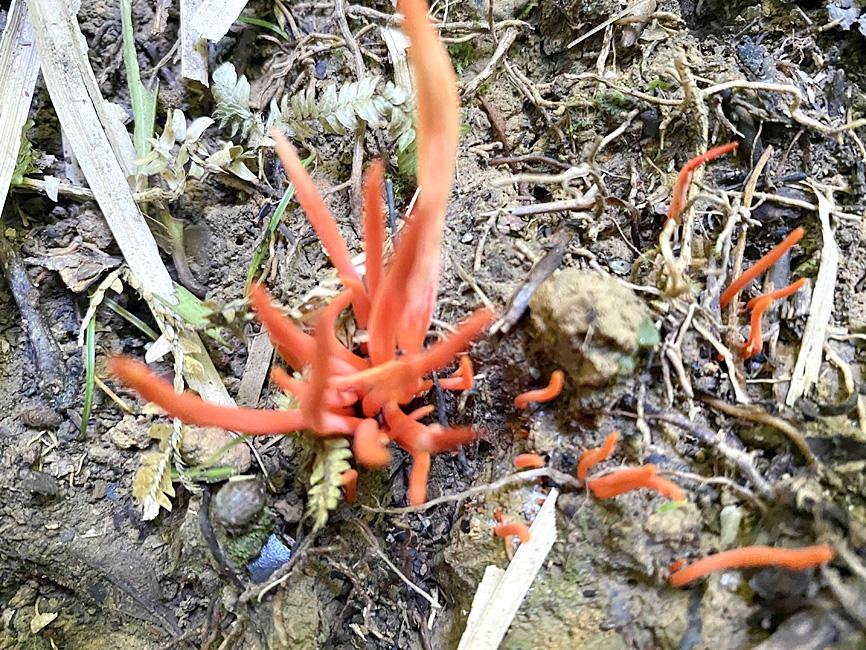An expert has warned against eating poisonous fungi after a hiker spotted what he thought was the world’s deadliest fungi, called poison fire coral, but which turned out to be a less harmful species, Clavulinopsis miyabeana.
A hiker surnamed Lee (李) on Saturday said that he took a photograph of a cluster of red fungi he saw on his way to Gaoyaoshan (高腰山) in New Taipei City’s Wulai District (烏來) last month.
After discussing the picture with a retired science teacher, they concluded that it looked like poison fire coral, also known as Podostroma cornu-damae, which is native to Japan, but has been found as far away as Australia.

Photo courtesy of hiker surnamed Lee
Lee became concerned that people might pick the bright red fungus for consumption.
Fungus expert Lin Tzu-chao (林子超), who published a paper on poison fire coral as a new species in Taiwan, said that the fungus in the picture Lee took is likely Clavulinopsis miyabeana, based on its appearance.
Poison fire coral has rodlike, solid, fleshy and reddish orange stromata that point upward and are white inside, Lin said, adding that they are 6cm to 10cm in height and 0.7cm to 1cm in diameter.
Clavulinopsis miyabeana is different in that it is hollow and rodlike, and 3cm to 4cm tall, he said.
Poison fire coral, a type of saprophytic fungus, grows in scattered patterns on the ground beneath broad-leaved trees, and its spores are dispersed by wind, Lin said.
It has been found in China, South Korea, and on Orchid Island (Lanyu, 蘭嶼), but not on Taiwan proper, he said.
While touching poison fire coral is not harmful, it must not be eaten, he said.
There was a case in South Korea of two people drinking water cooked with wild lingzhi mushroom they gathered without knowing that it contained a piece of poison fire coral, Lin said.
One died and the other suffered from desquamation of skin on the palms and soles, severe septicemia and organ failure, he said.
Consuming any type of poisonous fungus can cause vomiting, diarrhea and hallucinations, while poison fire coral additionally causes severe liver damage, he said.
There is no antidote for the poison, so those who have consumed it can only be treated with supportive therapy, he added.

Chinese Nationalist Party (KMT) Chairman Eric Chu (朱立倫), spokeswoman Yang Chih-yu (楊智伃) and Legislator Hsieh Lung-chieh (謝龍介) would be summoned by police for questioning for leading an illegal assembly on Thursday evening last week, Minister of the Interior Liu Shyh-fang (劉世芳) said today. The three KMT officials led an assembly outside the Taipei City Prosecutors’ Office, a restricted area where public assembly is not allowed, protesting the questioning of several KMT staff and searches of KMT headquarters and offices in a recall petition forgery case. Chu, Yang and Hsieh are all suspected of contravening the Assembly and Parade Act (集會遊行法) by holding

PRAISE: Japanese visitor Takashi Kubota said the Taiwanese temple architecture images showcased in the AI Art Gallery were the most impressive displays he saw Taiwan does not have an official pavilion at the World Expo in Osaka, Japan, because of its diplomatic predicament, but the government-backed Tech World pavilion is drawing interest with its unique recreations of works by Taiwanese artists. The pavilion features an artificial intelligence (AI)-based art gallery showcasing works of famous Taiwanese artists from the Japanese colonial period using innovative technologies. Among its main simulated displays are Eastern gouache paintings by Chen Chin (陳進), Lin Yu-shan (林玉山) and Kuo Hsueh-hu (郭雪湖), who were the three young Taiwanese painters selected for the East Asian Painting exhibition in 1927. Gouache is a water-based

Taiwan would welcome the return of Honduras as a diplomatic ally if its next president decides to make such a move, Minister of Foreign Affairs Lin Chia-lung (林佳龍) said yesterday. “Of course, we would welcome Honduras if they want to restore diplomatic ties with Taiwan after their elections,” Lin said at a meeting of the legislature’s Foreign Affairs and National Defense Committee, when asked to comment on statements made by two of the three Honduran presidential candidates during the presidential campaign in the Central American country. Taiwan is paying close attention to the region as a whole in the wake of a

OFF-TARGET: More than 30,000 participants were expected to take part in the Games next month, but only 6,550 foreign and 19,400 Taiwanese athletes have registered Taipei city councilors yesterday blasted the organizers of next month’s World Masters Games over sudden timetable and venue changes, which they said have caused thousands of participants to back out of the international sporting event, among other organizational issues. They also cited visa delays and political interference by China as reasons many foreign athletes are requesting refunds for the event, to be held from May 17 to 30. Jointly organized by the Taipei and New Taipei City governments, the games have been rocked by numerous controversies since preparations began in 2020. Taipei City Councilor Lin Yen-feng (林延鳳) said yesterday that new measures by